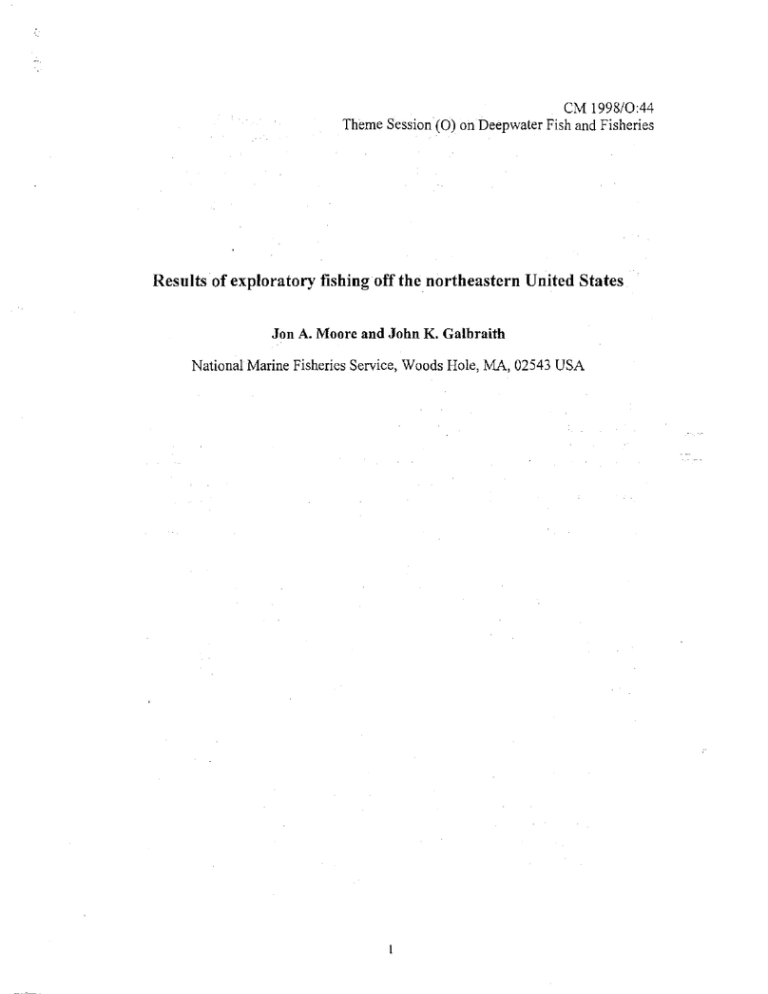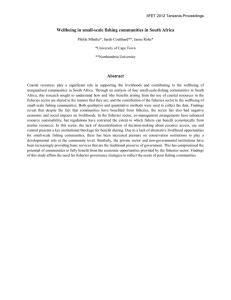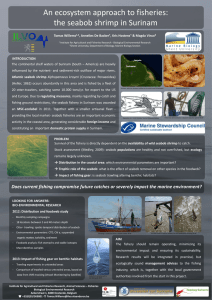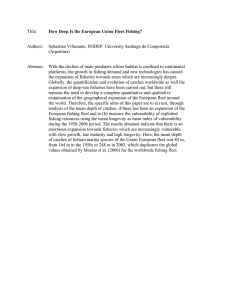Results of exploratory fishing off the northeastern United States eM
advertisement

eM 1998/0:44 Theme Session (0) on Deepwater Fish and Fisheries Results of exploratory fishing off the northeastern United States Jon A. Moore and John K. Galbraith National Marine Fisheries Service, Woods Hole, MA, 02543 USA Abstract From 1995 to 1997, exploratory deep-sea fishing was conducted along the continental slope, in canyons, and on certain seamounts by a few commercial fishers from New England. Most fishing occurred from the vicinity of Hudson Canyon to northeastern Georges Bank, and between depths of 31 0 and 1850 m. This fishing effort, and other recent research, have produced new findings concerning the composition of slope and seamount fish faunas within·this area, including the addition of 80 species new to the area. This corresponds to roughly a 15% increase in the total number of deep-sea pelagic and demersal species known off New England. Preliminary information is also provided on the catches and potential viability of commercial deep-sea fisheries in the region. A precautionary approach is recommended in the further development of deepwater fisheries. Introduction In the 1870s, the u.s. Fish Commission [progenitor to the present-day National Marine Fisheries Service (NMFS)] initiated an investigation of both shallow-water and deepwater fishery resources off the Atlantic coast of North America. The resulting studies on deepwater fish species produced many important scientific findings, but did not lead to the development of any deepwater fisheries. William Schroeder (1955) undertook further research into deepwater fishery resources off the northeastern United States from 1948 to 1953. Since Schroeder's time, extensive investigations of deepwater fishes in this area have been made by both NMFS and the Woods Hole Oceanographic Institution (WHOI). Despite this research, the potential of deep-sea resources was largely ignored because of substantial fishery resources available on the continental shelf. Recently, the decline in shallow-water fisheries and the increased regulation of those fisheries have led to further investigation into deepwater resources and the feasibility of such fisheries. In 1994, NOAA funded several exploratory fishing investigations off the northeastern United States. Operations included studies with various gears (i.e. bottomset longlines, otter trawls, midwater and bottom shrimp trawls, and squid jigs), at depths of 31 0-1850 m along the continental shelf edge and slope from Delaware to Georges Bank. The goals of this work were to determine the types of potential fishery resources available and the viability of commercial fisheries for these resources. We report on the results of these studies (excluding the squid jigging results), along with new faunal information generated since Schroeder's work in the 1950s. The deepwater fish fauna Along with Karsten Hartel and James Craddock, we are currently compiling an annotated checklist of deepwater fish species (tpuse-·typ.i~ally living below 200 m during the day) found off of New England. The information for this list is derived from a variety of sources, including published literature, fishes collected by NMFS and WHOI, and unusual fishes brought in by commercial fishers. We have been able to determine that at least 529 species of deepwater fishes live in the region stretching from offshore of Maryland to southern Nova Scotia (Table 1). Of these, at least 62 species are new records of occurrence in our area, and 8 are rare species known from less than 15 specimens worldwide. In addition, there are potentially 10 or more undescribed species. These 2 additions, which amount to 80 species, constitute a 15% increase in the known deep-sea fish fauna off New Englal1d. Given how well studied the deep sea is in this region, this is a surprisingly large increase in the known fauna and quite possibly serves as an indication of how little we know about the actual distributions of deep-sea fishes in general. The 529 deepwater fish species now known off New England represent a diverse deep-sea fauna, especially when compared to the 1094 species Merrett (1994) documented from the entire North Atlantic (extending from the southern edge of the Arctic Basin to the equator, including the Caribbean and Gulf of Mexico, but not the Mediterranean). This high diversity off New England may be explained by the confluence of a number of usually separate faunal provinces as a result of physical oceanographic processes. Cape Cod has long been recognized as marking a biogeographic boundary for the shallow-water fauna (Briggs 1974), and likewise there appears to be a faunal boundary for deepwater species in the area off New England. About 40% of the deepwater fish species found in our area are wide-ranging species with distributions extending from the tropics to boreal regions, while the other 60% have one end of their distributional range between Hudson Canyon and LaHave Bank off southern Nova Scotia. Of the species with one end of their range off New England, 10% of the species are boreal or subarctic fishes extending southward into our region. These may have been transported by the Deep Western Boundary Current (DWBC) which flows west and south at depths of 700-4000 m along the continental slope and rise from Labrador to Cape Hatteras and beyond (Pickart 1992). Examples of such subarctic fishes include Arctic skate (Raja hyperborea), Greenland halibut (Reinhardtius hippoglossoides), and northern wolffish (Anarhichas denticulatus). The DWBC may also explain the first occurrences in our area of a number of eastern Atlantic deep-sea species, such as the pallid chimaera (Hydrolagus pallidus) and spiderfish (Bathvpterois dubius). Howes (1991) suggested that amphi-Atlantic distributions might arise by fishes following dispersal corridors along the continental slopes around the northern perimeter of the Atlantic. The DWBC would aid in dispersing any eastern Atlantic species that manage to reach the Grand Banks or Flemish Cap. Another 11 % of the species whose distribution ends in our area are species characteristically found in the temperate waters of the Mid-Atlantic Bight; for example, the lantemfish (Symbolophorus veranyi). The final 79% of species that range to New England represent SUbtropical and tropical species typically found south of Cape Hatteras, but brought into our area by the Gulf Stream. Many of these species are mesopelagic or bathypelagic fish entrained in warm-core eddies, which break off from the Gulf Stream. Just a few examples of these warmer-water species include a lightfish (Yarrella blackfordi), lantemfishes (e.g., Diaphus brachycephalus, D. fragilis, D. garmani) a cusk eel (Luciobrotula corethromycter), and a number of grenadiers (e.g., Coelorinchus occa, Hymenocephalus italicus). In some cases, thermal tolerances determine where species are found. For example, some of the subarctic or boreal fishes found in our area prefer places where the bottom temperature is 3_4 0 C (e.g., Cottunculus thomsoni), which is the characteristic temperature for the Labrador Sea Water component of the DWBC (Pickart 1992). Some distributional ranges may also reflect ecological interactions. Forexample, Polyacanthonotus challengeri is widely distributed in the eastern Atlantic, but in the 3 western North Atlantic it overlaps with two other congeners and is limited to certain depths in the Mid-Atlantic Bight (Crabtree et al., 1985). Potential Ushery resources The exploratory fishers noted frequent occurrences of species of commercial or potential commercial importance, such as red crab (Chaceon guinguedens), goosefish (Lophius americanus), royal red shrimp (Pleoticus robustus), offshore hake (Merluccius albidus), white hake (Urophycistenuis), blue hake (Antimora rostrata), and smoothheads (Alepocephalus spp.). Smaller numbers of deep-sea squaloid sharks (Centroscyllium fabricii, Centroscymnus coelolepis, and Etmoptems spp.), chimaeras (Hydrolagus affinis, Hydrolagus pallidus, and Rhinochimaera atlantica), Acadian redfish (Sebastes fasciatus), black-bellied rosefish (Helicolenus dactyloptems), Greenland halibut (Reinhardtius hippoglossoides,and grenadiers (Coryphaenoides spp. and Macroums berglax) were also taken at times. Large amounts of red crabs were found between 300 and 600 m in our area by. both bottom trawlers and even the longliner. Average catch per unit of effort (CPUE) by one trawler was 360 kg/hr, and another trawler reported maximum catches of 1360 kg/hr in one tow. A study by NMFS estimated the sustainable yield of deepsea red crabs as 2700 metric tons annually or about 10% of the harvestable biomass (Wigley et al. 1975). High mortality and loss of legs in otter trawls prompted one captain to suggest beam trawls for harvesting this species. Currently, there is no commercial fishery for this species, which may stem from the. expensive requirements of either immediate at-sea processing to prevent degradation of the meat or refrigerated seawater systems for holding live crabs. Monkfish were found down to 900 m depth, but are already being exploited on the upper slope at 300-400 m. One vessel reported an average CPUE of36 kg/hr, with· several tow of 60 kg/hr using otter trawls. The deeper individuals are smaller (typically less than 60 cm, whereas shallower.individuals get to 90-100 cm in length). This size difference may reflect slower growth at depth or the possibility of a refuge for younger individuals at depth. . Scarlet shrimp (Plesiopeneus edwardsianus) were initially considered a potential target, but neither shrimp trawler found this species in sufficient quantities. One trawler did find royal red shrimp at depths of 320-800 m in concentrations consistent with commercial catch rates. This fisher achieved an average CPUE of 28 kg/hr. This catch rate is based on an average overall sampled locations rather than just at localized aggregations. Higher catch rates are therefore possible. Hauls of up to 91 kg/hr of smoothheads were noted below 900 m by the bottom trawlers and significant numbers of blue hake were caught on longlines below 1800 m. Both of these species produced suitable fillets, but when cooked the smoothhead reportedly turned to mush. One suggestion, which remains to be explored, was to investigate the ppssibility of using these species for the surimi market. Commercial viability Deep-sea fishing requires significant investment; the retrofits of existing vessels typical of the local fleet required $50,000-225,000. The need for specialized gear (often not available in the US), huge amounts of strong thin cable, and an extra-large power 4 supply for haulback increased the costs of conducting deepwater fishing. Processing at sea also requires expensive equipment and can be labor intensive. For example, because market acceptance and ex-vessel prices were botb higher for headed and frozen shrimp, the royal red shrimp were processed immediately after capture. The shrimp had to be sorted, graded, treated for melanosis, supercooled in a brine chill tank, and headed. The smaller 40-count shrimp also had to be deveined and butterfiied, and then all shrimp were quick-frozen and boxed. The crew could do tbis work between tows, but it was only economically feasible because the ex-vessel prices for processed frozen shrimp were $9II/kg. Unfamiliar fishes proved difficult to market. Many buyers were reluctant to bid for novel species. The ex-vessel prices received were often low and in many cases there were no buyers, even for species which are harvested and marketed elsewhere (e.g., grenadiers). In some cases, market acceptance grew after free samples were provided to buyers and restaurants. But market development will obviously be an integral part of creating a successful fishery for deepwater species. The need for a precautionary approach Deep-sea fisheries face a number of biologic, economic, and management challenges tbat go beyond those of shallow-water fisheries (Moore 1998a, Moore and Mace 1998). The greatest challenge is our limited information on the distribution, age and growth, and stock sizes for most potential deep-sea resources. Witbout tbis information, effective management is difficult. Some of those deepwater fishes, which have been studied so far, appear to have very low replacement rates resulting from a combination of slow growth, late maturity, low fecundity, and great longevity (e.g., orange roughy, oreos, grenadiers). Long-term sustainability of commercial fishing for species with such life histories is a major concern. Also, the ecological impact of particular fishing gears (e.g., otter trawls) and subsequent recovery rate of bottom ecosystems in the deep sea have yet to be determined. Since tbe deep-sea fauna is relatively diverse in our region, bycatch may become both an economic and an ecological issue. The use of a Nordmore grate on one shrimp trawler did eliminate a bycatch of larger fishes, such as moilkfish.Other means of reducing bycatch should also be explored. Management of deepwater resources will require a cautious approach to prevent rapid depletion of tbese resources [as recommended in FAO (1996)]. The relatively large accumulated biomasses for many of tbese deep-sea species do not necessarily translate into large sustainable commercial fisheries. The histories of some recent deep-sea fisheries show that overfishing can occur extraordinarily fast (Moore 1998b). Recovery of the stock after fishing pressure is removed often proceeds slowly. An extreme example is the fishery for slender alfonsino (Beryx splendens) on the Comer Rising Seamount, which peaked in its first year and failed to find large aggregations of these fishes for the next 10 years (Vinnicheilko 1997). Conclusions There is a diverse array of deep-sea fishes and crustaceans off New England, some of which might allow for commercial fishing. However, development of deepwater fisheries will require a precautionary approach if tbese fisheries are to be managed 5 sustainably. Biological studies and the historical record of serial depletion in certain deepwater fisheries indicate that the potential for deep-sea fisheries is limited. At this time, all of the funded exploratory fishers have returned to the more immediately lucrative shallow-water fishing with which they are most familiar. The otter trawlers and shrimpers, for example, have gone back to monkfishing and scalloping. One shrimper plans on doing more deepwater shrimping only after the scalloping season is over. Low catches and frequent loss or damage of gear have discouraged some from ever going back into the deep waters. Most fishers did recognize the potential for deepwater fisheries; however, because of the expenses and great deal of experimentation necessary, they seem reluctant to do much fishing in deepwater until there is no alternative. References Briggs, J. C.1974. Mariny zoogeography. McGraw-Hill, New York. 475 pp. Crabtree, R.E, K. J. Sulak, and J. A. Musick. 1985. Biology and distribution of species of Polyacanthonotus (Pisces: Notacanthiformes) in the western North Atlantic. Bull. Mar. Sci. 36 (2):235-248. F AO. 1996. Precautionary approach to capture fisheries and species introductions. FAO Tech. Guidelines Responsible Fish., 2. 54 pp. Howes, G. 1. 1991. Biogeography of gadoid fishes. 1. Biogeogr. 18:595-622. Merrett, N. R. 1994. Reproduction in the North Atlantic oceanic ichthyofauna and the relationship between fecundity and species' sizes. Env. BioI. Fishes 41:207-245. Moore, 1.A. 1998a. The challenges of deep-sea fisheries. Submitted to Proc. 17th Fisheries Week Azores, 12 pp. Moore, 1. A. 1998b. Deep-sea finfish fisheries: lessons from history. Manuscript undergoing internal presubmission review, 16 pp. Moore, J. A. and P. jv1. Mace.l998. Prospects and challenges for deep-sea finfish fisheries. Manuscript undergoing intemalpresubmission review, 14 pp. Pickart, R. S. 1992. Water mass components of the North Atlantic deep western boundary current. Deep-Sea Res. 39(9A):1553-1572. Schroeder, W. C. 1955. Report on the results of exploratory otter trawling along the continental shelf and slope between Nova Scotia and Virginia during the summers of 1952 and 1953. Pap. Mar. BioI. Oceanogr., Deep-Sea Res. 3(suppl.):358-372. Vilmichenko, V. I. 1997. Russian investigations and deep water fishery on the Comer Rising SeamoUjIt in Subarea 6. NAFO Sci. Counc. Stud. 30:41-49. 6 Wigley, R. L., R. B. Theroux, and H. E. Murray. 1975. Deep sea red crab, Geryon guinguedens, survey offnortheastem United States. Mar. Fish. Rev. 37:1-2l. 7 Table I. A list of fish families with numbers of species represented off the northeastern . US, from Maryland to southern Nova Scotia. Plus signs indicate one or more undescribed species also present. Myxinidae Petromyzontidae Chimaeridae Rhinochimaeridae Scyliorhinidae Pseudotriakidae Chlamydoselachidae Echinorhinidae Dalatiidae Squalidae Rajidae Halosauridae N otacanthidae Nettastomatidae Congridae Ophichthidae Synaphobranchidae Derichthyidae Serrivomeridae Nemichthyidae Eurypharyngidae Argentinidae Microstomatidae Bathylagidae Opisthoproctidae Alepocephalidae Platytroctidae Gonostomatidae Photichthyidae Sternoptychidae Stomiidae Ateleopididae Synodontidae Chlorophthalmidae Ipnopidae Paralepididae Alepisauridae Omosudidae Scopelarchidae N otosudidae Anotopteridae Everrnanriellidae I species I species 2 species 3 species 6+ species 1 species 1 species I species 6 species 1 species II species 5 species 5 species 3 species 3 species I species 6 species 2 species 2 species 3 species 2 species 2 species 1+ species 5 species 3 species 13 species 8 species 12 species 7 species 10 species 58 species I species 2 species 2 species 6 species IS species 2 species I species 3 species 4 species 1 species 3 species N eoscopelidae Myctophidae Lamprididae Trachipteridae . Regalacidae Polymixiidae Carapidae Ophidiidae Parabrotulidae Bythitidae Aphyonidae Macrouridae Steindachneriidae Moridae Melanonidae Macruronidae Bregmacerotidae Phycidae Merluccidae Gadidae Lophiidae Chaunacidae Ogcocephalidae Caulophrynidae Melanocetidae Himantolophiidae Oneirodidae Ceratiidae Linophrynidae Gigantactidae Stephanoberycidae Melamphaidae Barbourisiidae Rondeletiidae . Megalomycteridae Cetomimidae Berycidae Anoplogastridae Diretrnidae Trachichthyidae Macrurocytidae Parazenidae 8 2 species 69 species I species 3 species 1 species 1 species 1 species 15 species I species 1 species 1 species 17 species 1 species 8+ species I species I species I species 7 species 2 species 2 species I species 2 species 2+ species I species 2 species 3 species 8 species 3 species 5 species 4 species 2 species 10+ species I species 2 species I species 3 species 2 species 2 species 2 species 3 species I species I species Zeidae Grammicolepididae Caproidae Macroramphosidae Scorpaenidae Triglidae Cottidae Psychrolutidae Liparidae Acropomatidae Serranidae Polyprionidae Epigonidae Scombropidae Lutjanidae Malacanthidae Bramidae Caristiidae 2 species 2 species 2 species 1 species 6 species 3 species 2 species 2 species 4 species 5 species 2 species 1 species 5 species I species 3 species I species 3 species 2 species Bathyclupeidae Percophidae Uranoscopidae Chiasmodontidae Anarhichidae Zoarcidae Callionymidae Scombrolabracidae Gempylidae Trichiuridae Luvaridae Centrolophidae Nomeidae Ariommatidae Paralichthyidae Bothidae Pleuronectidae Cynoglossidae 9 1 species 1 species 1 species 4 species 2 species 8 species 1+ species 1 species 8 species 3 species I species 2 species 4 species 2 species I species 2 species 5 species 2 species






